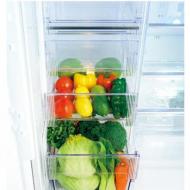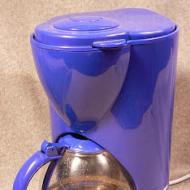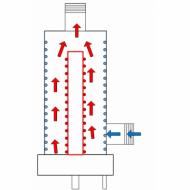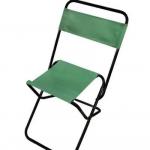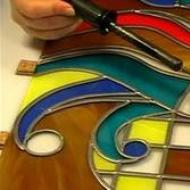
Who designed the espresso machine in 1945? The history of the coffee maker
For centuries and even millennia, coffee has been one of the most popular drinks in the world. No matter how they brewed it: in exquisite French coffee pots, Turkish cezves, and even in simple ladles! But despite the existence of many coffee recipes and methods of preparing coffee, the essence of the process remained the same - the drink was manually brewed over fire or hot sand. In the history of coffee, as well as in the history of all mankind, the 19th century turned out to be a turning point - the era of the heyday of technological progress or, as it is also called, the industrial revolution. The invention of the steam engine gave a serious impetus to the development of invention in general - people sought to somehow use this new product absolutely everywhere. It was then that the idea of creating a coffee machine that would prepare coffee using steam pressure was born. The first machine in which coffee was prepared using steam pressure was invented by the Frenchman Edward Loisel de Santé. In 1843, Loisel assembled a unique steam coffee maker, or “Loisel's hydrostatic vase,” as it came to be called in honor of the inventor. The machine debuted at the Paris Exhibition in 1855, where it created a huge sensation: according to eyewitnesses, it brewed about two thousand cups of coffee per hour. However, the bulky and inconvenient device had a lot of technical shortcomings - the coffee was burned in it, and the pressure of the steam boiler was too low (1.5-2 atmospheres). It turned out to be impossible to increase the pressure without changing the entire design: the device was extremely explosive. More than half a century passed before a new type of coffee machine appeared, in which steam under pressure was supplied to ground coffee. The idea of creating such a machine was born in Italy, and the Italians struggled to bring it to life for decades. And finally, in 1901, Milanese Luigi Bezzera registered a patent for the first improved steam coffee machine. It was much more compact and practical than all its predecessors. Bezzer's device, called Tipo Gigante, was fundamentally different from previous machines: its operation was based on the combined use of water and steam. Pressure in the coffee machine was created using a directed jet of steam. Such concepts as holder and group appeared - now each cup of espresso was prepared using a strictly measured portion of coffee. The process of preparing coffee took a matter of seconds, and the drink itself was strong, rich and aromatic. Luigi Bezzera introduced another innovation into the new espresso culture: from now on, the steam in the coffee machine was used not only for brewing espresso, but also for frothing milk. This was a real breakthrough. But, unfortunately, Bezzera turned out to be an unsuccessful businessman - he was unable to profit from his inventions, went completely bankrupt and was forced to sell the license for a nominal fee.
The right to produce coffee machines was bought by the successful Italian industrialist Desidero Pavoni, who was interested in the further development of coffee culture. In 1905, he founded the company La Pavoni SPA and produced the first steam coffee machine, Pavoni Ideale, intended for commercial use.
Desidero Pavoni improved the Bezzer apparatus, providing it with a piston pump, as well as a special valve for releasing steam and pouring hot water. By the way, it was Pavoni who is considered the discoverer of the “correct” espresso - through long experiments, he managed to discover that the best coffee is obtained at a temperature of 86-92 ºC and a pressure of 9 bar.
The first half of the 20th century was the era of the heyday of espresso preparation technology. Most of the world famous companies involved in the production of coffee equipment appeared in Italy during this period.
Coffee machine Rancilio La Regina
In 1927, the La Regina model appeared - a stylish coffee machine for bars and cafes, which was hand-assembled by the Italian Roberto Rancilio, the future founder of the world-famous Rancilio company. The operating principle of La Regina was no different from the coffee machines produced by La Pavoni, but its advantage was its elegant design in the Belle-Epoque style, which was appreciated by restaurateurs of that time.
In 1935, Francesco Illi developed the Illetta, the world's first automatic coffee machine. This is how the dosage standard for Italian espresso emerged, which has remained unchanged for many decades: 7 g of ground coffee per 40 ml of water. The Illetta machine had another significant difference from its predecessor coffee machines: the pressure of water passing through the ground coffee was created in it by compressed air, and not by steam. Although progress was evident, commercial espresso machines of the first half of the 20th century remained very bulky, expensive and difficult to operate. Only the richest establishment owners could afford such luxury. In addition, working with lever-type coffee machines required the barista not only skill, but also good physical training - after all, a pressure of 9 bar was created in them due to the muscular strength of the barista who held the lever. Naturally, in those days there were no women baristas. During the Second World War, the development of the espresso industry, as one might expect, stopped. But already in 1945, Achil Gadzhia designed another new product - a coffee machine equipped with a so-called “spring-loaded lever.” It was thanks to this invention that lush golden foam first appeared on the surface of the drink - the calling card of high-quality espresso. Later, lever coffee machines were replaced by semi-automatic and automatic coffee machines, the pressure in which was created by the operation of an electric pump. The first coffee machine equipped with an electric pump was released in 1961 by the Italian company Faema. Since then, the design of the classic carob coffee machine has remained essentially unchanged. The thing is that espresso has reached its perfection, and modern coffee machines fully meet all the requirements that restaurateurs, baristas and simply lovers of good coffee place on them. Despite this, coffee equipment manufacturers regularly release new products. New models of traditional coffee machines differ from older ones in their more modern design and the presence of some innovations, such as an automatic cappuccino maker, espresso quality control or a pre-wetting function for the coffee tablet.
Coffee maker is a culinary device that is used in the process of preparing a drink such as coffee. There are several main types of coffee makers, which differ not only in appearance, but also in their operating mechanism, and also in functionality.
Among the main types of coffee makers are the following:
- pod coffee maker;
- A drip coffee maker differs from other types in that during operation no pressure is created in the device, the water flows slowly and literally seeps through the coffee drop by drop;
- A geyser coffee maker is a device that consists of three main parts: a water container at the base of the device, a filter, which is located in the middle and into which ground coffee is placed, as well as an upper container into which ready-made coffee is supplied under pressure resulting from temperature exposure. to drinking coffee;
- A capsule coffee maker is a device that uses capsules with ground coffee;
- an espresso coffee maker is designed specifically for preparing this type of drink such as cappuccino, as well as classic espresso;
- carob coffee maker.
Initially, people used a device such as a Turk or cezve to brew coffee. However, scientific and technological progress has made its own adjustments in the process of preparing the famous and beloved coffee. An electric coffee maker is much more convenient to use than a cezve or Turkish coffee maker. This device does all the work for a person; you just need to pour coffee into the machine and start the process of preparing the drink.
This or that type of coffee maker varies depending on the set of functions that the device has. For example, some of the most expensive types of coffee makers include specialized coffee machines that not only prepare classic espresso, but also grind the coffee beans themselves. Modern coffee machines can prepare various types of drinks, such as cappuccino, latte, mochaccino and others.
This advantage allows the use of coffee machines in restaurants, bars, and coffee shops. A household coffee maker differs from a specialized one in size, as well as in its coffee making capabilities. Typically, a standard household coffee maker is not equipped with a design for grinding coffee beans. For this reason, the required amount of already ground or instant coffee is poured into the coffee maker.
In addition, the coffee maker is equipped with a water tank. During operation, coffee is passed through the filter of the coffee maker using a free flow of water. Typically, pre-ground coffee is inside a paper or metal filter, which is located inside a special funnel. This funnel is placed above a ceramic or glass container with water.
The operating principle of a household coffee maker is simple and consists of several stages. Initially, cold water is heated to a boil in a special container, and then, thanks to the structure of the coffee maker, it goes into a funnel. Experts say that coffee prepared using a metal filter can cause significant damage to the human body. A paper filter removes impurities and heavy compounds from coffee.
If you liked the information, please click the button
Coffee in the morning, yes, is already a habit and a necessity. The coffee maker becomes an inseparable attribute of the kitchen. Their price is affordable, the choice is varied, and they are familiar in themselves. We don’t even think about where their story comes from.
This culture in Western civilization arose about three centuries ago. It was then that our coffee drinking culture began to develop. The Dutch discovered coffee beans during sea voyages and began to grow it in their homeland. It was from Holland that the tradition of a cup of morning coffee spread. And soon the entire aristocracy indulged in this invigorating drink.
It is believed that the coffee maker was invented in 1800 by the French priest de Bellois. It was a drip coffee maker, where droplets of coffee seeped through the coffee grounds. A tinsmith named Morizz modernized it 19 years later, making it reversible.
Geyser coffee makers appeared in 1827. Coffee was prepared by repeated treatment with hot water and steam, forming a geyser in the glass. An engineer at the Scottish naval department, Napier, invented a vacuum coffee maker in 1840. In it, the water, having flowed over the layer of coffee, returned back under the influence of a vacuum. The compressed coffee maker was invented by the French inventor de Saintais in 1855. It steamed coffee at high pressure.
The Italian Luigi Bezzera created a machine for bars in 1901, which laid the foundation for modern coffee makers. The coffee maker has gone through a long and interesting path of transformation until now.
Companies Gaggia, Saeco, Briel, Krups, Delonghi, Spidem, Jura, Melitta are the main manufacturers. The prices are not particularly different, but the functionality is amazing in variety. Coffee makers are available to everyone today. A large selection awaits in stores, department stores, and the Internet. And in online stores prices are usually lower. http://odessa.foxtrot.com.ua/ru/shop/cofevarki.html
It's a matter of taste and the Foxtrot store (Odessa) will undoubtedly help you in your choice.
The coffee maker is chosen by true lovers of brewed rather than instant coffee. It makes the cooking process quick and easy. The variety of programs of the latest models of coffee makers will always ensure that you enjoy your favorite aromatic drink. What types of coffee makers are there?
It's not easy to buy a coffee maker for your home. It all depends on what kind of coffee you prefer. To make the right choice, it is better to familiarize yourself with the properties of these coffee makers.
Types of coffee machines
There are three types of coffee machines ( capsule , drip , espresso ) and mixed.
IN capsule coffee machines Usually they use pressed coffee in special capsules. In hermetically sealed packaging, which can be either aluminum or plastic, freshly ground coffee perfectly retains its delicate aroma and tenderness.
How does such a device work? The charged capsule is pierced over the entire surface, and a hole is made at the bottom. Then the contents of the capsule are mixed with a stream of air. Water is then supplied to the capsule under high pressure. In such machines, by adjusting the heat, you can froth milk for cappuccino.
A standout machine of this type is the capsule coffee machine. Nespresso , its developer is a design house DeLonghi . This machine allows you to prepare your favorite drinks: black coffee, espresso, latte or cappuccino. The convenient thing is that you don’t have to waste time cleaning and washing the machine; you throw away the used capsule and be done with it. This solution should appeal to busy office coffee lovers; good coffee is always on the table.
There are other coffee machines too. They contain an individually packaged capsule filled with tightly pressed coffee. There are rice paper filters at the top and bottom. It is through them that water heated to 96 degrees enters the capsule. Everything happens at a pressure of 16 bar. The process of brewing coffee resembles that of 100 years ago. This method of espresso was once invented by the Italians. As a result, you will get the most delicious drink.

Drip machines are considered the simplest and most accessible. In them, heated water gradually drips onto the ground coffee beans, taking in all the aroma. It turns out to be a good invigorating and stimulating drink. These coffee makers are the cheapest. In them, coffee does not release all the essential oils. This is only possible with espresso.

IN espresso Specially ground coffee is processed with special steam. There are two types of such machines - Pump-Espresso and Steam-Espresso. The pressure created inside the vessel releases the steam by opening the valve. Steam passes through the powder and is saturated with essential oils. The downside of this machine is that the water heats up to 100 degrees. And this is not very good; due to this temperature, too much caffeine is released, which is not very pleasing to its lovers. It is considered better if the coffee does not boil over.
In Pump-Espresso, pressure is created inside the boiler and the water is gradually heated. The temperature does not go off scale and does not exceed natural, providing amazing taste and aroma. This is also evidenced by the cost; not everyone can afford such a thing.
Filled water level indicator, everything is just super. Then you know exactly how many cups you will get and how much coffee you need to add. Still convenient auto-heating, it does not allow the coffee to cool down. And if you start it in the evening timer, so you can count on a leisurely treat with your favorite drink. You save both time and energy.
After using all the tips, you will definitely choose the right unit. He will pamper you in the morning with a cup of amazing drink.
History of coffee machines
The method of making coffee, invented by the medieval Arabs, which required only water, ground coffee beans and a simple metal vessel - a cezve, was good for everyone and for a long time completely suited humanity. Until the industrial era arrived in Europe and people became more impatient, so that they even needed coffee on an industrial scale.
Europeans really became concerned with the mechanization of the coffee-making process in the 1820s. These were the times when mankind was fascinated by a technical novelty called the “steam engine” and enthusiastically tried to make this miracle of engineering perform useful work in a variety of economic fields. In particular, a certain Frenchman Louis Bernard Babaut in 1822 came up with the idea that if you release a steam-water mixture under pressure from a steam boiler and pass it through ground coffee, then you can brew a lot of the drink quickly. Things didn’t come to the point of creating successful working models then, but the name of Monsieur Babot still remained in the history of coffee machine manufacturing, since his drawings and calculations were sent to the Paris Academy of Sciences.
In 1843, designer and coffee enthusiast Edward Loysel de Santais built the first steam coffee machine that was more or less suitable for commercial use. In 1855, after many years of improvements, the inventor showed the world his wonderful apparatus at the Paris Exhibition. This cumbersome device created a real sensation among its contemporaries. As visitors recalled, it stood in the open air in clouds of steam, like a steam locomotive ready to depart. The fireman fed coal into the firebox, the operator-machinist monitored the steam pressure in the boiler, poured several kilograms of ground coffee into a special hopper and, finally, pulled the impressive lever. And - lo and behold! - a wonderful drink began flowing from the tap almost non-stop at an insane speed of one thousand cups per hour. Long after this, the impressed French called any coffee maker "Leusel hydrostatic vases".
The first steam coffee machines had a lot of disadvantages. The most unpleasant thing is that they used to explode from time to time. Another drawback was that the coffee brewing parameters, such as extraction temperature and pressure, were far from ideal. The steam passing through the ground coffee was much hotter “correct” 86 - 93oC, therefore, the drink was “overburned.” At that time, it had not yet been experimentally established that the optimal pressure for extraction was 9 atmospheres, but the inventors felt that the 1.5 - 2 atmospheres that the steam boiler produced were not enough. However, increasing the pressure meant making the coffee machine even more explosive. In a word, other technical solutions were required, which were soon to appear.
By the beginning of the twentieth century, Italians had become the most devout coffee consumers in Europe. Italian matrons experimented in their kitchen, trying to figure out "golden formula" of a cup of coffee, family secrets of preparing the drink were passed down to heirs from generation to generation along with the will of property, and local restaurateurs vied with each other to invite clients to their “perfect coffee.” It is not surprising that in the conditions of such a public coffee boom, not only engineers and designers took up the invention of coffee machines.
In Italy, almost every street solderer, tinker and coppersmith tinkered in his workshop and built his own coffee machine. Actually, the most famous brands in the field of coffee machine manufacturing arose precisely in the first thirty years of the 20th century, and precisely from small workshops: La Pavoni (1905, Milan), La Cimbali (1912, Milan), La Marzocco (1927, Florence) etc. Many of today's world-famous concerns are named after single Italian artisans who devoted themselves to designing coffee machines with no less zeal than with which Amati, Stradivari and Guarneri made their unique violins several centuries earlier.
Very soon, the design of coffee machines became almost a national sport in Italy. The consequence of this craze was a real “patent war” - each inventor was in a hurry to stake out his priority and sometimes registered a patent with his last money. “Giuseppe ran to the patent office for the second time this morning,” neighbors would sometimes sneer at another craftsman. And indeed, brilliant ideas simply swarmed in the heads of Italian inventors.
In 1901 Luigi Bezzera improved the steam coffee machine and made it much more compact and practical. An important innovation was the system he invented for attaching the filter holder to the dispensing group, which is still used in traditional coffee machines to this day. Each cup was now brewed with a strictly measured portion of ground coffee. Another know-how Bezerra coffee machines- using steam in a boiler to froth milk and cream.
 In 1903 Desidero Pavoni acquired a patent from Bezerra for the production of coffee machines and in 1905 began their mass replication in his workshop. La Pavoni S.p.a. and to this day remains a highly respected brand among professional coffee making equipment.
In 1903 Desidero Pavoni acquired a patent from Bezerra for the production of coffee machines and in 1905 began their mass replication in his workshop. La Pavoni S.p.a. and to this day remains a highly respected brand among professional coffee making equipment.
Doctor Francesco Illy in 1935, he used compressed air instead of steam in his machine to supply water under pressure. Now it was not steam that was supplied to the coffee tablet, but water at the “correct” temperature, that is, slightly below the boiling point, and it became possible to increase the water pressure during supply. The inventor named the coffee machine in his own honor - “Iletta”.
 As coffee historians note, all commercial coffee machines of that time were still very bulky, expensive and difficult to operate devices that only reputable establishments could afford to attract clientele. The first La Cimbali machines from the early 1930s (Rapida model) were column-boilers of impressive size, under which a wood-burning firebox was placed. The emergence of a truly mass culture of espresso coffee in Italy became possible only after the so-called lever (from the English lever - lever) coffee machines. In them, the water pressure on the coffee tablet in the filter holder was created using a lever that operated a spring mechanism with a piston.
As coffee historians note, all commercial coffee machines of that time were still very bulky, expensive and difficult to operate devices that only reputable establishments could afford to attract clientele. The first La Cimbali machines from the early 1930s (Rapida model) were column-boilers of impressive size, under which a wood-burning firebox was placed. The emergence of a truly mass culture of espresso coffee in Italy became possible only after the so-called lever (from the English lever - lever) coffee machines. In them, the water pressure on the coffee tablet in the filter holder was created using a lever that operated a spring mechanism with a piston.
In this article we will talk about automatic coffee machines, what are their advantages and features. Coffee is one of the most beloved and popular drinks on earth, and probably every second person starts his day with a cup of aromatic and invigorating coffee, even if he has not yet fully woken up))
A cup of coffee, if prepared correctly, can awaken your desire to act, give you strength and confidence, and immerse you in an atmosphere of adventure and good mood.
This drink has been enjoyed for centuries, and therefore many recipes and options for making coffee have already been invented. The most famous and popular is Espresso.
To prepare this drink you need to follow several rules. One of which is having a good coffee machine.
Automatic coffee machines and coffee makers are not the same thing. A coffee maker can simply prepare coffee, and a coffee machine can grind beans for a fresher and more aromatic taste, dispense the desired portion, adjust the water hardness and the temperature of the finished drink.
History of creation
Before the advent of modern electrical appliances and various mechanisms, as a rule, they used jazvas, saucepans, metal jugs, and later they invented a drip coffee maker and a geyser.
But then, in 1901, Luigi Bezzer received a patent for the first espresso machine. Already in 1903, entrepreneur Desiderio Pavoni bought a license to manufacture Bezzera coffee makers, and in 1947, Italian inventor Achille Gaggia began producing semi-automatic coffee machines, where the required pressure is achieved by supplying powerful water pressure using a special lever (lever).
In 1961, the Faema brand replaced the lever with an electric pump that provides stable pressure.
Today, professional super automatic coffee machines with a full preparation cycle are already common (from grinding the beans to compacting them into tablets, setting the water supply temperature, etc.).

Delicious coffee is not only about the correct pressure and grind, but also about the right water and its optimal temperature. All this is now taken into account in modern automatic coffee machines, both inexpensive ones for offices and homes, and professional ones used in cafes and restaurants.
Coffee for automatic coffee machines
Typically, coffee machines use blends (coffee mixtures) consisting of different % ratios of Robusta and Arabica.
Arabica gives the drink a tenderness and soft taste, rich in nuances, while Robusta is richer and stronger, with a high caffeine content and is responsible for the formation of foam.

To choose good automatic coffee machines, pay attention to their quality, manufacturer and, of course, rich functionality, so that with a simple press of a button you can make real and tasty coffee.

